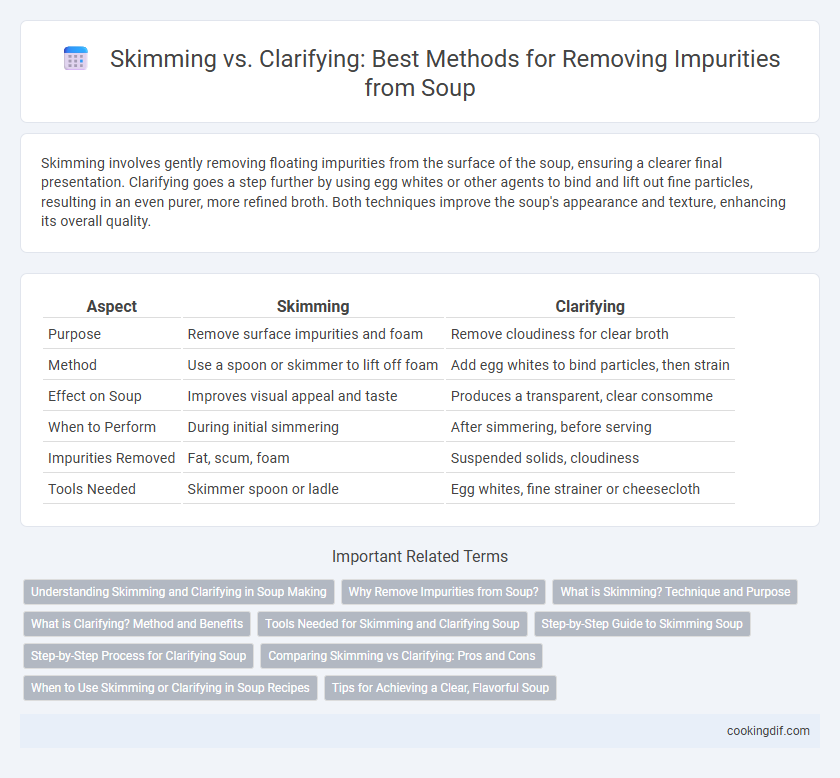Skimming involves gently removing floating impurities from the surface of the soup, ensuring a clearer final presentation. Clarifying goes a step further by using egg whites or other agents to bind and lift out fine particles, resulting in an even purer, more refined broth. Both techniques improve the soup's appearance and texture, enhancing its overall quality.
Table of Comparison
| Aspect | Skimming | Clarifying |
|---|---|---|
| Purpose | Remove surface impurities and foam | Remove cloudiness for clear broth |
| Method | Use a spoon or skimmer to lift off foam | Add egg whites to bind particles, then strain |
| Effect on Soup | Improves visual appeal and taste | Produces a transparent, clear consomme |
| When to Perform | During initial simmering | After simmering, before serving |
| Impurities Removed | Fat, scum, foam | Suspended solids, cloudiness |
| Tools Needed | Skimmer spoon or ladle | Egg whites, fine strainer or cheesecloth |
Understanding Skimming and Clarifying in Soup Making
Skimming removes surface impurities such as fat and foam during soup simmering, using a ladle or skimmer to ensure a clearer broth. Clarifying involves simmering the soup with egg whites or a clear stock to trap fine particles, resulting in a crystal-clear consomme. Understanding these techniques enhances soup texture and flavor, delivering a polished and visually appealing dish.
Why Remove Impurities from Soup?
Removing impurities from soup is essential to achieve a clear broth with a clean, refined taste and appealing appearance. Skimming removes surface foam and fat, while clarifying uses egg whites or other agents to trap finer particles, enhancing both texture and flavor. Purified soup prevents off-flavors and improves overall quality, making dishes like consomme more visually appealing and enjoyable.
What is Skimming? Technique and Purpose
Skimming in soup making is a technique used to remove impurities, foam, and fat that rise to the surface during cooking. This process involves gently using a spoon or ladle to carefully lift and discard these unwanted particles, resulting in a clearer and cleaner broth. The primary purpose of skimming is to improve the soup's appearance and taste by eliminating off-flavors and enhancing clarity.
What is Clarifying? Method and Benefits
Clarifying soup involves gently simmering a liquid with egg whites and sometimes ground meat or vegetables to capture and remove impurities, resulting in a clear and visually appealing broth. The egg whites coagulate and trap particles, which can then be skimmed off the surface, enhancing both the flavor and texture of the soup. This method produces a refined, transparent consomme prized in gourmet cooking for its purity and concentration of taste.
Tools Needed for Skimming and Clarifying Soup
Effective skimming of soup requires a fine-mesh skimmer or slotted spoon to remove surface foam and impurities without disturbing the broth. Clarifying soup involves straining through cheesecloth or a conical strainer to achieve a clear, impurity-free liquid. Both techniques benefit from temperature control tools like a thermometer to maintain optimal heat for removing particles efficiently.
Step-by-Step Guide to Skimming Soup
Skimming soup involves using a fine mesh skimmer or spoon to carefully remove impurities and foam from the surface during cooking, ensuring a clear and clean broth. Begin by simmering the soup gently to allow impurities to rise, then slowly skim them off without disturbing the liquid. Repeating this process at regular intervals enhances the soup's clarity, resulting in a visually appealing and better-tasting dish.
Step-by-Step Process for Clarifying Soup
Clarifying soup involves a precise step-by-step process that begins with gently heating the broth to just below boiling. Gradually whisk in a mixture of egg whites, ground meat, and vegetables, known as a clarification raft, which binds impurities as the soup simmers. Once the raft solidifies and rises to the surface, strain the clear broth through a fine sieve or cheesecloth, removing the raft and resulting in a transparent, impurity-free soup.
Comparing Skimming vs Clarifying: Pros and Cons
Skimming removes impurities by gently lifting foam and fat from the surface, preserving the broth's natural flavor but requiring frequent attention during cooking. Clarifying involves straining the broth through a mixture of egg whites and ground meat, producing a crystal-clear soup with enhanced visual appeal but a longer preparation time and slight flavor alteration. Skimming is faster and simpler for everyday soups, while clarifying suits refined recipes demanding pristine clarity and presentation.
When to Use Skimming or Clarifying in Soup Recipes
Skimming is ideal during the initial simmering phase to remove surface foam and fat, ensuring a clearer broth without altering flavor. Clarifying is best reserved for rich, gelatinous stocks like consomme, where egg whites trap fine particles to produce a crystal-clear liquid. Use skimming for quick impurity removal in everyday soups, and clarifying when precision and transparency are essential for presentation and texture.
Tips for Achieving a Clear, Flavorful Soup
Skimming removes surface foam and fat to prevent cloudiness, while clarifying uses egg whites to trap fine particles for a crystal-clear broth. To achieve a clear, flavorful soup, gently simmer rather than boil and regularly skim impurities with a fine mesh ladle. Using fresh ingredients and straining the broth through cheesecloth enhances clarity and depth of flavor.
Skimming vs Clarifying for removing impurities Infographic

 cookingdif.com
cookingdif.com